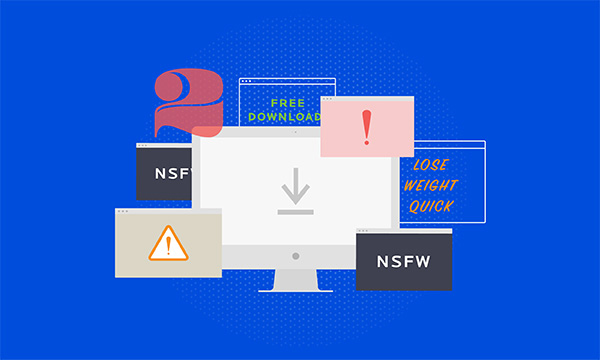All things you need to know about adware (adware)
Are you on the Internet but constantly bothered by unhealthy web sites that automatically pop up in the middle of the screen? Your Home Page is naturally replaced by an unknown site where?
You find a way to get rid of them by resetting the Internet Explorer home page, restoring all of the default Restore Defaults parameters, or if you're a computer expert, you've found and turn off all programs that are loaded at startup . But it doesn't work, they're still like "ghosts" hiding and persistently clinging to your computer. You wonder, what are those "ghosts" really and why can they 'sneak' into their computers? These are the manifestations of Adware-infected PCs. So what is Adware, what kind of adware are there and how to fix it when infected with adware? We will find out in this article.
Learn about adware - adware
- What is adware?
- How does 'adware' get into your system?
- Types of popular adware
- Adware on Mac
- Adware on mobile devices
- History of adware
- Who are the victims of these adware?
- What to do when infected with adware?
- How to protect yourself from adware?
What is adware?
Adware is unwanted software designed to appear ads on your device screen, usually in a web browser. Some security experts consider it a precursor to PUP (Potentially Unwanted Program) unwanted programs. Usually, it uses a sneaky method to camouflage to become legal and comes with another program to trick users into downloading it to desktops, tablets or mobile devices.

Adware benefits its developers by automatically displaying online ads in the user interface of the software or on the screen during the installation process. And then you will see super-fast weight loss programs, provide quick enrichment tips and even "invite" fake virus alerts you click on. In addition, you can see new tabs that automatically open, change your browser homepage, results from search engines you have never seen before or even redirect to another page.
This happens when legitimate software applications use online advertising with ads that are often bundled in the program and displayed in the way that program developers specify. You can download adware to your computer without knowing it, because it hides in legitimate software. And you will see some computer programs showing ads that are not coming from the websites you are visiting.
When adware enters your device, it can perform all kinds of unwanted tasks. The functionality of the software can be designed to analyze the location and website you visit, then display ads that match the type of goods or services you view. Although adware is more annoying than threatening your network security like malware, but if the adware developer sells your browsing activities and information to third parties, they may even Use it to target you more ads depending on your browsing habits. And no matter which web browser you use, such as Chrome, Firefox, etc., it appears ads.
Here are a few typical signs that your system has adware:
- Ads appear where it should not appear.
- The homepage of the web browser has mysteriously changed without your permission.
- Sites you often visit do not display properly.
- Linking sites that redirect to other websites is not what you want.
- The web browser is slow.
- The toolbar, new extension or plugin suddenly appears on the browser.
- Macs start automatically installing unwanted software applications.
- Browser crashes.
How does 'adware' get into your system?
There are two main ways that adware is used to hack into your system. The first way is that you download programs that are usually freeware (freeware) or trial software before a shareware and it will quietly install adware without your permission. That's because the program developers have registered with the adware provider. Users who want to use free software must accept advertising (although even paid software from unreliable sources may have adware in it).

The second way is when you access an adware-infected website, taking advantage of a web browser vulnerability, adware will be downloaded to the drive. After getting into the system, adware starts collecting your information, redirecting to malicious websites and throwing more ads into the browser.
Types of popular adware
By the way on the adware that has infiltrated your computer or other devices, it changes the web browser that users do not know or disagree with. Usually it will change the homepage and default search settings. When you surf the web and see the ads appear, you will assume that it appears from the website you visit but not so, it can be from your system.
There are several adware for different devices and operating systems. So you may have to deal with mobile adware / Android, Mac adware or Windows adware.
Adware on Mac
Many people believe that Mac users are not afraid of adware because Mac has an integrated anti-malware system called XProtect, a pretty good tool for detecting known malware. In fact, cybercriminals often focus primarily on Windows computers but recently this situation has changed. The special Adware for Mac first appeared in 2012 and then the Mac version of the adware has increased rapidly, it seems legitimate to hackers and criminals organized by the organization as well as in corporations. affirmed to sell real software to users. Adware of these companies is hidden in an installation part of the software, often the reader ignores it. So when you click on the agreement, you accept to download it to the system.
The sign that the Mac is infected with adware is similar to that on Windows. You will see advertising windows appear, sometimes changing the browser homepage without your knowledge, navigating to another site. It even replaces new search engines. Although Mac is less vulnerable than Windows, it still has problems with adware.
Adware on mobile devices
When a mysterious icon appears on the screen, the ads do 'obstruct' the notification bar, you know you have 'unwelcome' adware guests. It's no surprise that thousands of Android apps contain adware.
There are two ways adware can get into mobile devices: through web browsers and download applications.
-
Adware infiltrating mobile devices through the browser is due to the way browsers handle redirection implemented by JavaScript code. This causes pop up ads to appear. The best way to block pop up ads is to use a different browser, disable JavaScript, or install extension to block ads. Another remedy is to go back to the previous page or delete the history, cache. You can refer to the article How to block pop-up ads in all browsers.
-
Adware infects your mobile device through downloaded software. They operate in various forms, from full-screen advertising in or outside the infected application to device notifications, on the lock screen. Typically, third-party app stores often install adware application types, so you should avoid app stores like this.
Although adware is an annoying pest, it's not as dangerous as malware. Many of the free apps you download to your phone often contain third-party advertising content, which they can earn when providing free software for you.
History of adware
Initially, around 1995, experts considered the first ad-supported software to be part of a larger type of spyware. Soon, security experts began to differentiate adware from spyware as a less harmful PUP. They are even considered legitimate, at least theoretically because legitimate businesses have created adware.
But these legitimate business affiliates often promote their adware without the adware vendors checking its legitimacy. Because the work is not tested, adware is enhanced in many ways according to their preferences.
After a while, adware vendors began to close affiliates 'bad practices and denied responsibility for their affiliates' actions. After that, the government began to impose a fine on this violation, causing major adware publishers to give up. Recently, adblocker ad blocking tools and adblock plugins have become popular on web browsers, blocking ads on browsers, protecting users from adware, causing websites to lose revenue from legitimate ads.
Today, although adware still exists, it is considered a form of unwanted PUP program with a lower level of risk than malware. However, adware is reviving perhaps due to the rise of mobile devices and adware in mobile applications. Adware manufacturers today are consolidating power, they use more powerful techniques like hidden Trojian, combined with adfraud components, rootkits, etc., making them difficult to remove.
- Differentiate viruses, trojans, worms and rootkits
Who are the victims of these adware?

The main adware target is the individual user. It tracks them through any route that can range from Windows, Mac computers to mobile phones and most browsers.
What to do when infected with adware?
If you suspect that there is adware on your Mac or Windows computer, you can take some measures to fix the problem. Refer to the article Completely remove Adware and Spyware on your system.
How to protect yourself from adware?
To avoid adware, be careful before downloading and installing any new software, especially free software. Read terms and conditions before agreeing. Avoid torrent sites, illegal software download sites and never open applications from an unknown source, even if it comes to you under the guise of a known email contact. Finally, download a reputable network security program for computers and mobile phones and perform regular scans.
See more:
- Top best antivirus application for Android phones
- Instructions from A-Z how to remove advertising programs on Windows computers
- Remove root malware (malware) on Windows 10 computers
- 14 most effective anti-spyware software
You should read it
- How to Manually Remove Adware
- How to use the Bitdefender Adware Removal Tool to remove adware on Windows
- Completely remove Adware and Spyware on your system
- How to remove the root virus ExtTag.exe / ExtTags.exe
- Adware and spyware are now ... rootkits
- How to remove Adware Tracking Cookie when a computer is infected
 How to use SpyHunter to remove spyware, anti-keylogger
How to use SpyHunter to remove spyware, anti-keylogger Completely remove Adware and Spyware on your system
Completely remove Adware and Spyware on your system How does malware get into smartphones?
How does malware get into smartphones? 5 things to do to avoid malware
5 things to do to avoid malware If you don't want to be a victim of Ransomware, read this article
If you don't want to be a victim of Ransomware, read this article How to detect VPNFilter malware before it destroys the router
How to detect VPNFilter malware before it destroys the router